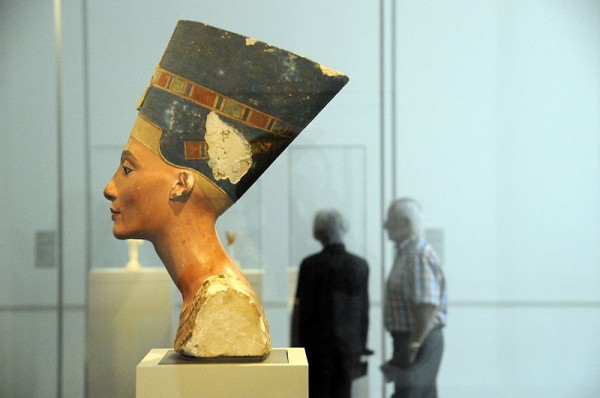
Image by Jesús Gorriti, via Wikimedia Commons
Last October, two artists, Nora al-Badri and Jan Nikolai Nelles, paid a visit to the Neues Museum in Berlin and–so the story goes–scanned the 3,000-year-old bust of Nefertiti using a hidden Kinect motion sensor. The resulting 3D scans later became available to the world on a website called “Nefertiti Hack,” with the following preface.
From today on everybody around the world can access, study, print or remix a 3D dataset of Nefertiti’s head in high resolution. This data is accessible under a public domain without any charge, this torrent provides you a STL-file (100 MB)…
“Nefertiti Hack” goes on to say: “ ‘The Other Nefertiti’ is an artistic intervention by the two German artists Nora Al-Badri and Jan Nikolai Nelles. Al-Badri and Nelles scanned the head of Nefertiti clandestinely in the Neues Museum Berlin without permission of the Museum and they hereby announce the release of the 3D data of Nefertiti’s head under a Creative Commons Licence.… With regard to the notion of belonging and possession of objects of other cultures, the artists’ intention is to make cultural objects publicly accessible.”
As if not already controversial, this act of artistic vigilantism recently became more contentious when 3D scanning experts started questioning whether Al-Badri and Nelles could have produced such high quality scans with a Kinect hidden under a jacket (shown on a video here). It seems implausible, they say. And it has left some wondering, writes The New York Times, whether Al-Badri and Nelles “somehow acquired the museum’s own scan of the bust, scanned a high-quality copy or produced the scan by some other means.” The answer is not yet clear.
In the meantime, according to Hyperallergic, the artists themselves used their scans “to create a 3D-printed, one-to-one polymer resin model” of the Nefertiti bust, which, they claim, “is the most precise replica of the bust ever made.” And that bust “will reside permanently in the American University of Cairo later this year as a stand-in for the original, 3,300-year-old work that was removed from its country of origin shortly after its discovery in 1912 by German archaeologists in Amarna.”
If there are updates to the story, I am sure Hyperallergic will have them.
via New York Times/Hyperallergic
If you would like to sign up for Open Culture’s free email newsletter, please find it here. It’s a great way to see our new posts, all bundled in one email, each day.
If you would like to support the mission of Open Culture, consider making a donation to our site. It’s hard to rely 100% on ads, and your contributions will help us continue providing the best free cultural and educational materials to learners everywhere. You can contribute through PayPal, Patreon, and Venmo (@openculture). Thanks!


Leave a Reply